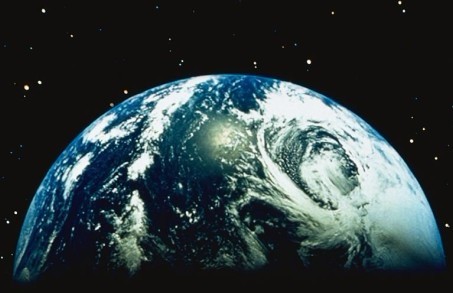These the fluctuations would grow to form galaxies. So if it wasn't for those little density fluctuations, you and I would not be here today.
物质分布的密度不断涨落,范围逐渐扩大,最后形成星系。如果没有密度的涨落,你我也就不复存在了。

Our universe is now 380,000 years old and trillions and trillions of miles across. Clouds of hydrogen and helium gas flowed through space. It will take another 200 million years before those gases create the first stars.
现在我们的宇宙年龄为38万年,已经延伸了数万亿英里。氢气和氦气云在延伸的空间里流动。再过2亿年这些云才能创建出第一颗恒星。
The first stars ignited the universe into what must have been the most amazing firework. The universe went from the dark cages to an age of splendor when the first starts illuminated the gas and the universe began to glow, the majestic fashion that we should be in.
第一批恒星点亮了宇宙,璀璨绚丽,可与世上最神奇的烟花相媲美。宇宙从黑笼子时期进入到一个辉煌的时代:第一批恒星在氢气和氦气里燃烧,宇宙就开始闪耀起来,就像一场宏伟的时尚秀,人类也将应该参与其中。
It was like Christmas tree lights turning on. The universe began to light up in all directions until you form the beautiful mosaic we now see today.
这就像闪烁着灯光的圣诞树。宇宙被照亮了,光芒万丈,因此我们就能看见漂亮的如宝石般镶嵌在太空里的星星。
More and more stars turn on. One billion years after the Big Bang, the first galaxy forms. Over the next eight billion years, countless more take shape. Then about five billion years ago, in a quiet corner of one of those galaxies, gravity begins to draw in dust and gas. Gradually, they clump together and give birth to a star - our sun. Nine billion years after the Big Bang, our tiny solar system springs to life and with it, planet Earth. Everything there is exists because of the Big Bang and it's still going on. Our universe is still expanding, but it won't just keep going forever. Our universe had a beginning, and it will also have an end.
越来越多的恒星亮起来了。大爆炸后10亿年,第一个星系形成了。在接下来的80亿年,又出现了无数个星系。大约50亿年前,在浩渺星系的一个安静角落里,重力开始吸附尘埃和气体。渐渐地,它们凝聚成团,我们的太阳就因此诞生了。大爆炸后90亿年,渺小的太阳系因地球上生命的出现而充满生机。大爆炸是万物的起源,它仍然在进行。我们的宇宙仍在持续膨张,但它不会永远膨胀下去。宇宙有开端,也有结尾。











